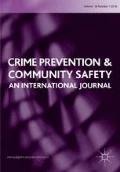Abstract
This research explores the relationship between community social organization and neighborhood rates of mortality. Community social organization is a latent term that captures a variety of social interactions between residents that bring individuals together, providing an opportunity for a collective response to perceived neighborhood problems. Drawing from social disorganization theory, I suggest that more efficacious communities should have lower rates of mortality, particularly for youth. Using survey and secondary data for Chicago neighborhoods, I find that social organization (measured as collective efficacy) has a strong protective effect in terms of reducing youth death rates. The impact of collective efficacy holds for both preventable and health-related youth mortality. Results suggest that neighbors may contribute to protecting the lives of youth by helping mobilize residents to engage in community social organization.
Similar content being viewed by others
Author information
Authors and Affiliations
Corresponding author
Rights and permissions
About this article
Cite this article
Feinberg, S. Community Social Organization as a Predictor of Mortality: Analyzing Chicago Neighborhoods. Crime Prev Community Saf 8, 150–168 (2006). https://doi.org/10.1057/palgrave.cpcs.8150023
Published:
Issue Date:
DOI: https://doi.org/10.1057/palgrave.cpcs.8150023




